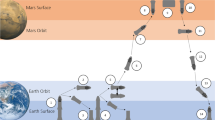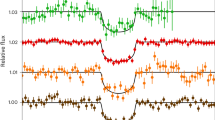Abstract
THE past year has witnessed increasing interest in solar-powered, electrical propulsion systems for spacecraft in both the United States and the United Kingdom. In the United States the main interest is in the use of electrical propulsion for missions to Mars and Jupiter, where there is a marked payload advantage over chemically powered spacecraft which are limited by their energy rather than by their power. The incentive for the United Kingdom to initiate development in this field was provided by Burt1 who theoretically showed that it was possible to change independently all the elements of a spacecraft's orbit by means of small continuous thrusts from an electrical propulsion unit. In particular, he showed that the ability of the unit to change the inclination of an orbit made it possible for a communications satellite launched from a non-equatorial site to attain a geostationary orbit.
This is a preview of subscription content, access via your institution
Access options
Subscribe to this journal
Receive 51 print issues and online access
$199.00 per year
only $3.90 per issue
Buy this article
- Purchase on SpringerLink
- Instant access to full article PDF
Prices may be subject to local taxes which are calculated during checkout
Similar content being viewed by others
References
Burt, E. G. C., Planetary and Space Science, 15, 103 (1967).
Wolf, M., and Ralph, E. L., I.E.E.E. Trans. on Electron Devices., 12, No. 8 (August, 1965).
Wysocki, J. J., et al., App. Phys. Lett., 9, No. 1 (July, 1966).
Author information
Authors and Affiliations
Rights and permissions
About this article
Cite this article
CRABB, R., TREBLE, F. Thin Silicon Solar Cells for Large Flexible Arrays. Nature 213, 1223–1224 (1967). https://doi.org/10.1038/2131223a0
Received:
Revised:
Issue date:
DOI: https://doi.org/10.1038/2131223a0
This article is cited by
-
Polymer electrolytes for flexible zinc-air batteries: Recent progress and future directions
Nano Research (2024)
-
Flexible solar cells made with crystalline silicon
Nature (2023)
-
Flexible solar cells based on foldable silicon wafers with blunted edges
Nature (2023)
-
Ultra-thin chips for high-performance flexible electronics
npj Flexible Electronics (2018)



